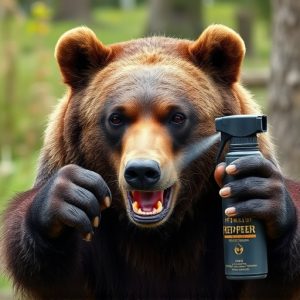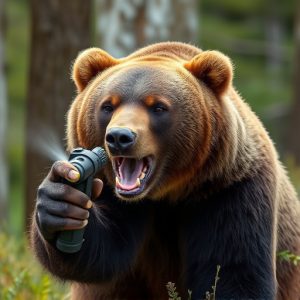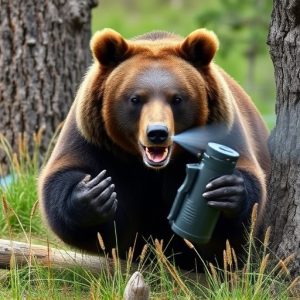Maximizing Defense: Bear Spray Fog Pattern Test and Selection Guide
Bear spray, a vital tool for outdoor enthusiasts in bear-infested areas, uses capsaicin from chili p…….
Bear spray, a vital tool for outdoor enthusiasts in bear-infested areas, uses capsaicin from chili peppers to create an irritant fog pattern that deters bears. The Bear Spray Fog Pattern Test is crucial for ensuring its effectiveness, evaluating how well the spray disperses to reach bears' eyes, nose, and mouth. This scientific method involves releasing the spray into the air and studying its dispersion using specialized equipment, providing data on impact radius and optimal application techniques. Key factors include the spray's fog pattern, maximum strength (higher capsaicin concentration), and environmental conditions, with specific consideration for bear species encountered. Choosing a product requires understanding your environment, bear behavior, wide fog patterns, high capsaicin concentrations, ease of use, and weather-resistant cans.
In the wild, understanding bear spray—a maximum-strength defense weapon—is crucial for outdoor enthusiasts. This article explores the basics and history of bear spray, delving into key components with a focus on the Bear Spray Fog Pattern Test to assess its effectiveness. We dissect factors influencing performance and guide readers in choosing the right bear spray tailored to their needs, ensuring safety in potential encounters. Explore these insights for an informed approach to wildlife protection.
- Understanding Bear Spray: The Basics and Its History
- Bear Spray Fog Pattern Test: Methodology and Results
- Factors Influencing Bear Spray Effectiveness
- Choosing the Right Bear Spray for Your Needs
Understanding Bear Spray: The Basics and Its History
Bear spray, also known as bear repellent, is a powerful defense weapon designed to protect individuals from aggressive bears in their natural habitats. This non-lethal self-defense tool has become an essential item for hikers, campers, and anyone venturing into bear country. The primary purpose of bear spray is to create a barrier between the user and the bear by releasing a fog pattern that contains capsaicin, the active ingredient derived from chili peppers.
The history of bear spray dates back to the 1960s when early formulations were developed as a way to protect outdoor enthusiasts from grizzly bears in North America. Over time, these products have evolved, with advancements in formula and delivery systems. The Bear Spray Fog Pattern Test is a critical component of ensuring that these sprays function effectively. This test evaluates how well the spray disperses, ensuring it reaches the bear’s eyes, nose, and mouth, ultimately deterring aggressive behavior.
Bear Spray Fog Pattern Test: Methodology and Results
The Bear Spray Fog Pattern Test is a crucial methodology employed to evaluate the effectiveness and range of bear spray, a powerful personal defense weapon against aggressive bears. This test involves releasing the spray into the air and observing its dispersion pattern. Researchers use specialized equipment to measure the distance and density of the fog, simulating various real-world scenarios. By analyzing the results, experts can determine the optimal range for successful bear deterrence.
During the test, a controlled amount of bear spray is released from a specific distance, typically ranging from 20 to 50 feet. High-speed cameras and laser rangefinders capture the moment, providing detailed data on the fog’s expansion and coverage area. The results reveal critical information about the spray’s impact radius, ensuring users understand the necessary application technique for maximum protection. This scientific approach allows for informed decisions when selecting bear spray as a defense mechanism in potential bear encounters.
Factors Influencing Bear Spray Effectiveness
The effectiveness of bear spray as a defense weapon depends on several key factors. One crucial aspect is the spray’s fog pattern, which significantly impacts its range and coverage. A successful Bear Spray Fog Pattern Test ensures that the spray forms a dense, even cloud capable of reaching the bear and effectively deterring it. This means choosing products with proven patterns that blanket the animal in the repellent chemicals.
Another influencing factor is the concentration or strength of the active ingredients. Maximum-strength bear spray offers a higher concentration of capsaicin, the primary irritant, which can provide longer-lasting protection against aggressive attacks. Moreover, environmental conditions like wind and temperature play a role; optimal conditions ensure the spray stays effective during use, while adverse weather might reduce its reach and impact.
Choosing the Right Bear Spray for Your Needs
When selecting a bear spray, understanding your specific needs and environmental factors is key. Consider the types of bears you might encounter; black bears tend to avoid confrontations, while grizzlies may require a stronger spray. The range and reach of the spray are also critical; opt for one with a wide fog pattern test result, ensuring it can cover the distance needed to create a barrier between you and the bear.
Look for sprays with a high concentration of capsaicin, the active ingredient, as this will increase its effectiveness. Check product reviews and consider factors like ease of use, weather-resistant cans, and any additional features that could enhance your safety during outdoor adventures in bear country.
In conclusion, understanding the dynamics of bear spray effectiveness is paramount for ensuring safety in encounters with these majestic yet potentially dangerous creatures. The Bear Spray Fog Pattern Test serves as a valuable tool, revealing key factors that influence its performance. By considering elements like can size, fog pattern, and active ingredients, individuals can make informed decisions when choosing the right bear spray for their specific needs. Staying prepared and informed is essential in navigating the outdoors responsibly and confidently.


